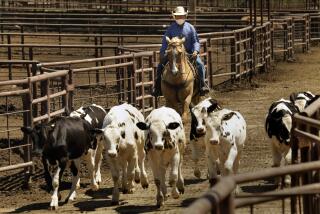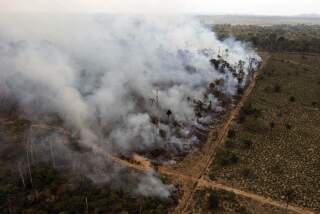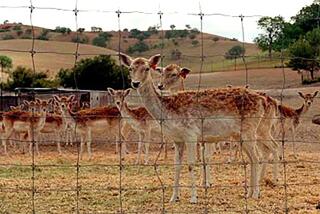Soybeans now rule the range on Argentina plains
As a kid, fifth-generation Argentine cattleman Mario Caceres often dressed up in a beret, bandanna and baggy pants called chiripas to emulate his country’s gauchos, the nomadic cowboys who once ruled the Pampas and who still symbolize rugged independence, chivalry and expert horsemanship.
His head full of the romantic tradition of the gaucho, glorified in songs and the epic poem “El Gaucho Martin Fierro,” Caceres built a successful ranching business that once totaled 1,600 head of Angus, one of the breeds that made the name “Argentina” synonymous with beef.
“Cattle was never a business to me but a way of being, a philosophy,” Caceres, 45, said one morning last month as he greeted a visitor at his ranch 150 miles west of Buenos Aires. “Cattle give you open skies, freedom and nature, and teach you the virtue of patience because the results come slowly. That’s something very beautiful.”
But Caceres is slowly bidding adios to gaucho ways, swapping his livestock for something safer, faster and vastly more profitable: soybean crops.
The economic reality of the global commodities boom has trumped starry-eyed dreams of a storied past for Caceres and hundreds of other Argentine ranchers. Turns out the same soil and climate conditions that make Argentina ideal for cattle also make it primo soybean terrain. Add in a tripling of global soy prices over the last decade, pushed up by the biofuels market and food demand from Asia, and you have a massive migration to soy around these parts.
Over the last four years, Caceres has converted half of his ranchland to soy fields while reducing his livestock to just 130 head, which he says he keeps for mainly sentimental reasons. The horse and lasso he once used have been swapped for an all-terrain vehicle, which is perfectly suitable for monitoring his inanimate soy crops.
Growing soy, a low-cost crop that can yield two harvests a year, is a virtual no-brainer. Newborn cattle, on the other hand, take three years to bring to market and are inherently riskier investments, requiring expensive veterinary care and fences.
At the end of the day, growing soy can be twice as profitable per acre as raising cattle, said Gustavo Duarte, an agronomist and consultant with DZD Agro based in America, a town in Buenos Aires province.
“The world changes and your mind has to be open to it. Today it’s soy, tomorrow it will be some other crop,” said Duarte, who has advised Caceres and other ranchers on the shift to crops. “The Pampas are no longer the open plains with a gaucho sipping mate in the shade. Now it’s a green industry, motorizing the entire economy.”
Adding to the disincentives of cattle are political pressures. To ensure domestic supplies of affordable beef for her highly carnivorous constituents, populist President Cristina Fernandez de Kirchner has placed tough export restrictions and price controls on beef.
Caceres joined fellow ranchers in demonstrating against the government export and price measures in 2008 in blockades that shut down national highways and often turned violent. He now says the demonstrations were a mistake.
“Conditions change and you play by the rules that are made or find something else to do,” said Caceres, a thoughtful, friendly man of few words, who, wearing a gaucho bandanna and rakish beret, could pass for Argentina’s version of the Marlboro Man.
The tour of his ranch included a stop at a barn where he proudly showed off not a prize bull or stallion but two brand-new farm machines, a Crucianelli planter and a Massey Ferguson tractor. Each cost $100,000, he said.
The shift by ranchers away from raising cattle to growing soybeans and other row crops is causing a steady diminution of Argentina’s once immense cattle herds and centuries-old tradition of gauchos connected to them.
Still, even if working gauchos are now about as common as American cowboys — they began to disappear in the early 1900s — they remain closely connected to the national identity.
“In the heart of every Argentine exists a gaucho, for the qualities that he represents: respect, hospitality and generosity,” said Adolfo Caballero, president of the Argentina Gaucho Federation, a 1.6-million-member social and charitable group.
The total cattle herd in Argentina is about 47.9 million head, down 17% from the 58.3 million as recently as 2007, according to the national cattlemen’s association. Meanwhile, the national harvest of soybeans this year is expected to reach 50 million tons, compared with the 30 million tons harvested a decade ago. Some experts expect the harvest to increase by an additional 20 million tons by the end of the decade.
Even though Caceres and his wife own their two ranches and are not subject to rising rent as are other farmers, he said they were paying a steep “opportunity cost” for not growing soy. Property taxes have risen sharply with rising property values. So has the cost of living as the windfall from soy sales filters through the local economy.
“Cattle are no longer as economical,” Caceres said. “Globalization affects us all.”
The boom has been good for Argentina, which is third behind the United States and Brazil as the world’s leading producers of soy, a high-protein food especially popular in China and India.
The rising harvest has played an important role in the country’s economic turnaround from the dark days of its 2001 economic crash. Economic growth will reach 8% this year, on top of 9% expansion last year, according to United Nations forecasts.
And Caceres doesn’t deny that the shift to soy has been lucrative for him, though he won’t say how much. “You can stick to the gaucho philosophy,” he said with a wry twinkle in his eyes, “or you can make the money to afford a BlackBerry, a new SUV, video games for the kids and a trip to Disney World, as I have.”
He regrets the new priorities but puts them in context of the changes sweeping the world. For example, he now gets twice-daily updates on soy prices at the Chicago Mercantile Exchange over his BlackBerry, whereas he used to have to read about cattle prices a day later in the newspaper.
He now dedicates time every morning to reading about global economic trends and is convinced that high soy prices are here to stay with demand from China still rising, along with the domestic market created by the use of soy in biofuels.
“Prices are historically high, but I think there will always be a good market,” he said. “The world can’t get enough of soy, and buyers keep coming.”
Cattle ranching eventually will be pushed out of the Pampas and other flatlands to more mountainous “marginal areas,” where the soil, pasture land and climate are not as optimal, said the gaucho federation’s Caballero. More beef will be raised in feedlots, Caceres said, with the possible loss of the flavor that has made range-fed Argentine beef so distinctive.
“The spirit of gauchos still remains,” Caceres said. “But soon you’ll have to go to a parade to see one. “
Kraul is a special correspondent.
More to Read
Start your day right
Sign up for Essential California for news, features and recommendations from the L.A. Times and beyond in your inbox six days a week.
You may occasionally receive promotional content from the Los Angeles Times.






